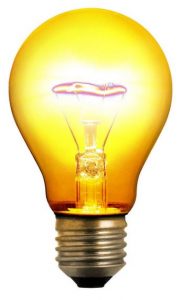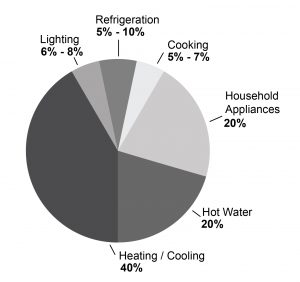Let me address a common and serious misconception before we get started. Home energy efficiency has absolutely nothing to do with solar panels. If your whole house was built out of solar panels with a continual line of sight to the sun, this would have no more impact on the energy efficiency rating of your home than getting your electricity via an extension cord from the house next door. It is true that some sources of energy are more energy efficient than others, and that’s why our household cooks with gas, but the gas, or the solar energy, or the 15 amp extension lead from your neighbour’s garage is merely your energy supply. How efficiently that energy gets used determines how energy efficient your home is.
“Being energy efficient is simply using energy efficiently so as to consume the minimum amount of energy to achieve an identical outcome”. John Lynn
 I frequently inquire using the analogy of asking “how many miles per gallon does your house get”? What I’m really asking is, “how energy efficient is your home”. To clarify, let us consider the analogy of a business that has two motor vehicles with exactly the same capacity, ie. they can transport the same amount of product with the same comfort and speed but imagine that one of those vehicles consumes twice as much fuel as the other does to do exactly the same job. Clearly the one that uses half as much fuel is twice as energy efficient. Now imagine two homes, located next door to each other, housing the same number of people of exactly the same ages with identical jobs and hobbies. Should one of those homes have a quarterly bill that is twice that of the other, then the home that uses half the energy is clearly twice as energy efficient as the other.
I frequently inquire using the analogy of asking “how many miles per gallon does your house get”? What I’m really asking is, “how energy efficient is your home”. To clarify, let us consider the analogy of a business that has two motor vehicles with exactly the same capacity, ie. they can transport the same amount of product with the same comfort and speed but imagine that one of those vehicles consumes twice as much fuel as the other does to do exactly the same job. Clearly the one that uses half as much fuel is twice as energy efficient. Now imagine two homes, located next door to each other, housing the same number of people of exactly the same ages with identical jobs and hobbies. Should one of those homes have a quarterly bill that is twice that of the other, then the home that uses half the energy is clearly twice as energy efficient as the other.
You may well ask “is this even possible”?
It is not only possible but significant variations in energy consumption between, what appears to be very similar households, are quite common. Because every household is different and one size does not fit all, households that appear to be very similar, may, in reality, be very different. While there are a large number of reasons why this may be so, let’s just examine one simple possibility.
Let’s assume that these two identical households require lighting in the same number of rooms for the same number of hours each day, however one household is still using incandescent bulbs whilst the house next door is using LEDs. One of the reasons why one home will be more energy efficient than the other will become clearly apparent.
There are four different types of light bulbs commercially available for homes. They include incandescent, halogen, CFLs (Compact Fluorescent Light) and LEDs, (Light Emitting Diode). Incandescent light bulbs are the old standard and are not that readily available. They have a number of desirable characteristics but one of them is not energy efficiency.
You may not require as much light in, for example, the toilet, as you may require in a living area. Each family will decide how much light they need and where they need it. For our analogy, each home requires the same light brightness for the same length of time each day in each identical room.
The brightness of a light is measured in lumens. A 40 Watt incandescent bulb produces approximately 450 lumens. A halogen light bulb can produce 450 lumens but consumes only 29 Watts. A CFL can produce the same amount of light whilst consuming only 11 Watts and an LED will do the same job consuming only 9 Watts. Inefficiencies or energy lose/wastage may occur in a number of ways however incandescent light bulbs produce a high level of electrical resistance which causes energy losses through heat generation. The heat is an undesirable consumer of energy and does nothing to increase the lumens produced. Should one household use exclusively incandescent light bulbs and the other used exclusively LED light bulbs, one household will use approximately four times as much energy to produce the same amount of light for the same amount of a time in the same number of rooms as the other.
 Using LED lighting in your home allows your home to operate more energy efficiently giving you more bang for your buck by producing more lumens for your dollar. I don’t know too many households that would be happy using only 450 lumens of brightness in each room. Two and three and even four times as much lighting is desirable in some areas. Our pantry has an LED that produces 1600 lumens. It makes it a lot easier to find what you want when you can see what you are looking at. Our pantry uses 20 Watts of energy to perform that task whereas a CFL would consume 23 Watts, a halogen bulb would consume 72 Watts to do the same job and an old incandescent bulb would use 100 Watts which is five times as much as a 20 Watt LED. A home that used 100 Watt incandescent light bulbs throughout the house would use 5 times as much electricity for their lighting, under identical circumstances, as a home with 20 Watt LEDs.
Using LED lighting in your home allows your home to operate more energy efficiently giving you more bang for your buck by producing more lumens for your dollar. I don’t know too many households that would be happy using only 450 lumens of brightness in each room. Two and three and even four times as much lighting is desirable in some areas. Our pantry has an LED that produces 1600 lumens. It makes it a lot easier to find what you want when you can see what you are looking at. Our pantry uses 20 Watts of energy to perform that task whereas a CFL would consume 23 Watts, a halogen bulb would consume 72 Watts to do the same job and an old incandescent bulb would use 100 Watts which is five times as much as a 20 Watt LED. A home that used 100 Watt incandescent light bulbs throughout the house would use 5 times as much electricity for their lighting, under identical circumstances, as a home with 20 Watt LEDs.
Exclusively using LEDs in your home will not reduce your electricity bill by 80% because lighting only represents 6 to 8% of a home’s electrical energy consumption. Occupants in a household who prefer the whole house, and maybe half of the backyard, illuminated every night will spend a higher percentage of their energy bill on lighting and so each hold is unique, and in this scenario, will benefit more from using the energy efficient bulbs possible.
All these little savings add up. Using the most energy efficient products where possible will make a difference to your bill. Then there are the habits of the homes occupants to consider.
Our household’s electrical consumption is in the vicinity of only 1/5 to 1/4 of a similar household because we use many energy efficiency “best practices”. That is, we have “automatic” behaviours that are “habitual” practices that also make our home more energy efficient. If you want only one cup of coffee, then do not fill the jug with enough water to make four or five. If you do, you will use four or five times more energy than was required to do the job. Should you have these wasteful habits across a wide range of practices then your home’s electrical consumption could very easily be many times more than what appears to be a similar household.
Get your FREE copy of “Savvy Up and Save” here >>>LEARN MORE>>>
Moreton Bay residents can access weekly tips from John on Community Radio 101.5 FM Friday Mornings at 10:10am
John Lynn
